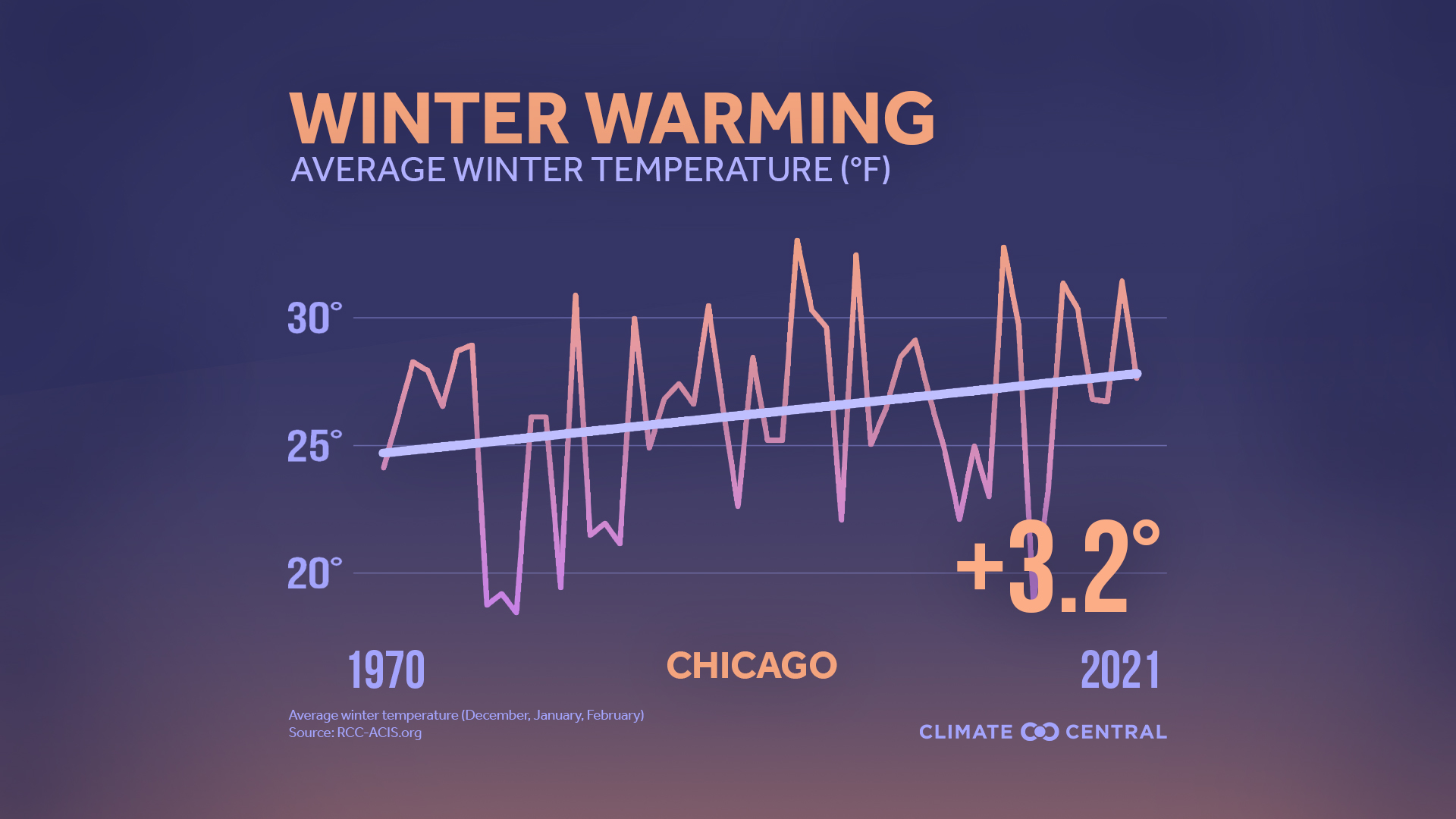
Climate Change and Chicago Winters
Whether you’re a Chicagoland native or a freshman from California experiencing your first Windy City winter, it’s not hard to understand why Chicago is infamous for having one of the harshest winters in the country. In the winter season, Chicago gets an average 28.1 inches of snowfall and has an average temperature of 26.4F, but the wind from Lake Michigan can sometimes make it feel like it’s colder than Siberia. However, with climate change, Chicago winters are – well – changing.
Warming Winters
When you think of climate change in connection with changing winter seasons, your first thought may be one related to warming – and you’re spot on. According to Climate Central, winter is the fastest-warming season in the majority of the U.S., including Chicago. Since 1970, Chicago’s winters have warmed an average of 3.2F.

Average winter temperature in Chicago in degrees Fahrenheit
Source: Climate Central
By mid-century, Chicago is projected to have 22 fewer days per year with a minimum temperature below 32F. While we may benefit from this rise in temperature in the form of more bearable commutes, energy reductions in heating, reductions in cold-related mortality, and a longer growing season, the adverse effects outweigh the good.
Warmer Winters are Snow Good
Winters (and springs) are going to get a whole lot wetter. Warmer air holds more moisture, about 4% more water vapor per 1F of warming. More open water on the Great Lakes, due to less ice cover, also contributes to more evaporation. As temperatures rise and days below freezing drop, precipitation is expected to increase but snow cover is expected to decrease. This precipitation is likely to be heavier, resulting in more severe flooding events, which can lead to decreased water quality, fertilizer runoff contributing to algae blooms and bacteria, and a delayed planting season. A reduction in ice coverage and increase in the frequency of severe storms exacerbate flooding, harm fish habitats, damage property, and make the Great Lakes more vulnerable to erosion.
Polar More-tex?
In its 171 years, Northwestern has only canceled classes six times due to weather-related reasons. The most recent cancellation came in January 2019, when the polar vortex brought the coldest temperatures Chicago has seen in 34 years: a bone-chilling -21F, with the wind chill dipping down to -51F. Though it may seem counterintuitive, a warming world may bring more cold snaps like these to Chicago.
The Arctic polar vortex is a large area of low-pressure and cold air that circulates around the North Pole. This swath of chilly wind usually stays constrained to the Arctic by a polar jet stream. However, when the temperature difference between the jet stream and mid-latitudes shrinks, the jet stream becomes weaker and distorted. A weakened polar jet stream cannot deflect warm air masses as they move north and allows frigid air from the Arctic to seep further south.
Stable and disrupted polar vortex
Source: National Oceanic and Atmospheric Administration Climate Central
The Arctic is warming four times as fast as the rest of the planet, decreasing temperature differences between the Arctic and mid-latitudes. Rapid warming is believed to distort the polar jet stream and is likely linked to the increased frequency of polar vortex events. The 2019 polar vortex that engulfed Chicago was the third one the city had endured in five years and, according to researchers, these visits from our Arctic neighbor will become more common.
What Can You Do?
The effects of climate change are already tangible and, while we acknowledge that this can be anxiety-inducing or outright petrifying, there is still time to take action.
Get Involved
- Join one of the 20 environmentally-oriented student groups on campus.
- Donate to or volunteer at the various environmental non-profits based in Chicago.
- Contact your elected representatives to voice your concerns about climate change.
Stay Informed
- Follow @sustainNU on Instagram and Twitter to stay up-to-date on sustainability events happening on campus.
- Read about climate news, nationally or locally.
- Consider taking a class on the environment or climate change.
Engage Others
- Have a conversation with your friends, family, and community about climate change.
- Amplify messages from those who are fighting climate change.
